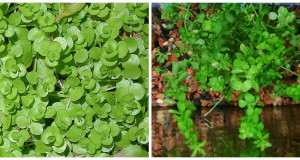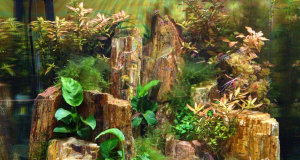Hello, Frank Indiviglio here.
 The culture of live algae and plants in brackish aquariums has not been given much attention, and few plants native to estuaries and similar environments are commercially available. However, as with fresh water tanks, live plants add a whole new dimension to aquarium-keeping, and are extremely interesting in their own right.
The culture of live algae and plants in brackish aquariums has not been given much attention, and few plants native to estuaries and similar environments are commercially available. However, as with fresh water tanks, live plants add a whole new dimension to aquarium-keeping, and are extremely interesting in their own right.
In brackish exhibits at the Bronx Zoo and in my own tanks, I have experimented with several varieties of algae and plants. In addition to mangroves, Java ferns and other such estuarine-adapted species, a surprising number of plants and algae that are typically thought of as either “marine” or “fresh water” can be acclimated to brackish environments. Following are a few of my favorites.
Acclimatization
Plants and algae should be introduced carefully to a brackish water aquarium…treat them as you would a fish or invertebrate. Particularly as concerns fresh-water plants, sudden changes in pH can wreck havoc with osmotic pressure, causing cell rupture and the death of the specimen.
Marine Algae
Marine algae are commonly referred to as “seaweeds”, but they are in actuality not true plants. Single or multi-celled, algae lack roots, stems and leaves, but have evolved equivalent structures. For example, holdfasts act as roots in anchoring them to the substrate, but do not absorb nutrients…that role is taken on by the leaf-like portions of the organism.
Caulerpa prolifera
This is the most commonly-available marine algae. It ranges from Florida and the Caribbean southward, and is commercially cultivated. Caulerpa spreads via rhizomes, or runners, and, although a true marine algae, it adjusts well to brackish environments.
Like all algae, Caulerpa may leak fluids when pruned, so be sure to clip only a tiny amount at a time if trimming is necessary. Related species, with rounded, pointed or fern-like shapes, are sometimes seen in the trade.
Other Types of Marine Algae
A number of other types of marine algae are sometimes available. While not as well-suited to a brackish water existence as Caulerpa, several will adjust if care is taken in the acclimatization process.
I and colleagues have had varying degrees of success with sea cactus (Udotea flabellum), Codiacea spp., mermaid’s cup (Acetabularia spp.), mermaid’s shaving brush (Penicillus capitatus) and several types of red algae.
Brackish Water Plants
Java Fern, Microsorium pteropus
 To my knowledge, the Java fern is the only true brackish water aquatic plant that is regularly available to aquarists. In well-lit tanks it will proliferate rapidly. A number of fishes favor Java fern leaves as food, but its rapid growth rate can accommodate this in many cases.
To my knowledge, the Java fern is the only true brackish water aquatic plant that is regularly available to aquarists. In well-lit tanks it will proliferate rapidly. A number of fishes favor Java fern leaves as food, but its rapid growth rate can accommodate this in many cases.
Red Mangrove Seedlings, Rhizophora mangle
Mangrove seedlings, or propagules, are semi-aquatic, with the roots usually submerged and the plant itself growing above water. The red mangrove is often sold in the trade and is commercially propagated in Florida, where it also occurs naturally. Red mangroves are extremely wide-ranging, being found along coastlines in many of the world’s tropical and subtropical regions. At home in estuaries, salt marshes and along river mouths, they are adapted to fluctuating salinity levels, and fare well in brackish water aquariums.
Mangroves can be planted in mud or wedged into limestone, and, because of their semi-terrestrial nature, are best kept in aquariums housing mudskippers, fiddler crabs and other creatures that utilize both land and water areas. They excrete salt on the surface of their leaves…this should be washed away with fresh water every few days.
Mangroves often grow slowly in the aquarium, and stay at a manageable size for some time. There are a few techniques for dealing with tall plants…please write in if you would like further information.
Eelgrass, Zostera marina
Eelgrass is one of the only true plants to live an aquatic existence in marine environments. It is not commonly kept in aquariums. I have had mixed success with it, but have observed healthy stands in commercial aquariums (if you are interested in this plant, please write in and I’ll make some inquiries to public aquarium contacts).
Eelgrass populations have plummeted in the northeastern USA and elsewhere, and I encourage those with an interest to work with this plant (please note that collection is prohibited in California and elsewhere). An incredible assortment of unique fishes and invertebrates, such as pipefishes, dwarf seahorses and eelgrass-shaped amphipods, are always found in association with eelgrass beds.
I commonly observe eelgrass in estuaries, lagoons and other brackish habitats, and it thrives in true marine water as well.
Next time I’ll discuss some of the many fresh water plants that can be acclimated to brackish conditions. Please write in with your questions and comments. Thanks, until next time, Frank Indiviglio.
Brackish environments are home to many fascinating fishes and invertebrates that do well in aquariums. Please see my article on Mudskippers for a look at one of the most unusual.
 That Fish Blog – Aquarium Advice and Information
That Fish Blog – Aquarium Advice and Information




Hi
Is there a minimum sg to grow Caulerpa, i have a brackish setup of about .07 ish would this be ok or would i have to increase the salinity.
thanks
j decruz
Hi James,
Most Caulerpas will need salinity of at least 20 ppt or a specific gravity of 1.014 or they will start to degrade. Some species may be a little more tolerant, but generally they need a higher salt content than what you’re maintaining. Depending on the fish you have, you should be able to raise the salt levels as most brackish fish can easily adapt to the higher salinity.
Thanks for the great insight!
Hey,
I am looking for types of sea grasses for my brackish water aquarium with mono fish. Any suggestions would be helpfull.
Thanks,
Mark
Hello Mark, Marine grasses aren’t typically available anymore; I haven’t seen any available from any of the suppliers we use at our store for well over a year or two. Some types that you may be able to find are commonly known as Turtle Grass, Eel Grass or kelp but I haven’t seen them typically used in a brackish water aquarium so I wouldn’t be able to speak to their hardiness in that type of environment. Even in a full marine environment, plants like that are very difficult to maintain long-term.
Thank you for your reply. What aquatic plants would you suggest for a brackish water aquarium (1.007)SG with mono fish?
Hello Mark, I would agree with the recommendations for the plants and algae discussed in this blog and in Part 2: Adapting Freshwater Plants to Brackish Aquariums.
Thank you.
Mark
I’m interested in eel grass. I was wondering about brakish water stingrays and sharks. I was also wondering if box cow fish could kept gs 1.012 or and copper banded butterfly fish.
Hi Chris, There are some sharks, rays and skates that occasionally travel into brackish waters but few that live there all the time. Most of the species in the aquarium trade are going to be fully marine and wouldn’t do well at a Specific Gravity of 1.012. Copperband Butterflies do need a much higher salinity as well but take a look at Mono’s…they are fairly similar in appearance and much better suited to brackish water. I can’t think of any boxfish or cowfish that can be kept permanently in brackish water. Like the sharks and rays, some may travel into brackish water (especially as juveniles) but need higher salinity as they mature. There are some puffers and burrfish that can live in brackish water that would be better suited.
Hi I was wondering are there any corals or clams counchs tolerate lower salinity. For a brakish water aquarium.
Hi Chris, No, unfortunately there are not any corals that can tolerate brackish water. There are a few inverts that can tolerate brackish water but they aren’t really found very often in the aquarium hobby.
I have a paludarium set up with salinity running from 1.005 to 1.010. Two mudskippers, a figure 8 puffer, 2 bumble bee gobies, a knight goby, a molly and some nerite snails. It has two mangrove sprouts growing well. Any marine algae or plants you would recommend trying? Thanks!
Hello Adrienne, Mangroves are by far the most poular and common for brackish water tanks but I would recommend those mentioned in this article and in Part 2 as some other options.
Hi! I have 7 ppt salinity and would like to ask you if you know the fastest growing algae or plant (for nutrient exporting) for this condition and also what would be the micronutrients for these commercially available specimens so to function properly. I will have Tilapia in this tank and will have a conditioning tank with a space and grow ligths to export phosphates and nitrates. Hardiness and growth speed is what I am looking to get also.
Thank you and I will continue to my research.
Hi Enrique, That salinity is very low for macroalgae and most freshwater plants that are used for nutrient export can’t tolerate salt. You could try Caulerpa as discussed in this blog but there are few plants available to aquarists that can tolerate brackish water.